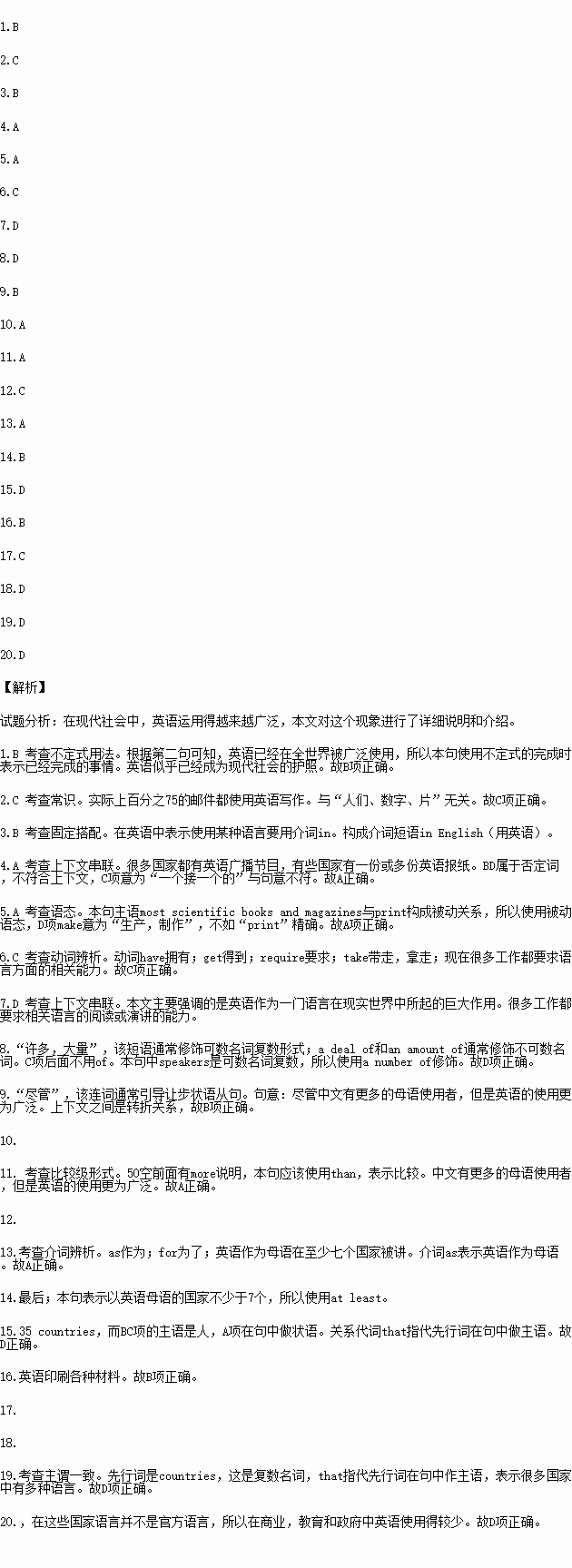题目内容
English seems ________ the passport(护照) to our modern society. About half the world’s newspapers and 75 ________ of the world’s mail is ________ English. Many countries have special shortwave radio broadcasts in English and some have ________ English-language newspapers. Most scientific books and magazines ________ first in English. Many jobs ________ a reading or speaking knowledge of the ________.
English has a large ________ of speakers. Even ________ there are more ________ speakers of Chinese ________ English, the use of English is ________ widespread. It is spoken ________ a native language in ________ seven countries, and there are more than 35 countries ________ have English as one of their official languages. That ________ that the government publishes laws and information in ________, and sometimes classes at schools ________ in English. In countries that ________ speakers of many languages, English is sometimes the unofficial language. In these countries English is used ________ in business, education, and government.
1.A. to haveB. to have becomeC. beD. being
2.A. peopleB. numbersC. percentD. pieces
3.A. forB. inC. withD. about
4.A. one or moreB. fewC. one by oneD. no
5.A. are printedB. are producingC. are makingD. are made
6.A. haveB. getC. requireD. take
7.A. EnglishB. magazinesC. booksD. language
8.A. dealB. amountC. manyD. number
9.A. throughB. thoughC. thatD. because
10.A. nativeB. foreignC. people’sD. good
11.A. thanB. withC. whichD. as
12.A. muchB. veryC. moreD. many
13.A. asB. to beC. beingD. for
14.A. moreB. at leastC. above allD. in the end
15.A. whereB. whoseC. whomD. that
16.A. saidB. meansC. followsD. thinks
17.A. languagesB. ChineseC. EnglishD. words
18.A. gaveB. had givenC. teachesD. are taught
19.A. becomeB. areC. isD. have
20.A. manyB. a great dealC. littleD. less
 阅读快车系列答案
阅读快车系列答案We are a primary school in England. Our students start arriving at our playground from about 8:45 a.m. Most of the children live nearby, so they walk to school. But some children have to travel to school by car. Each of the children is dressed in a school uniform (校服) and carries the homework and packed lunch in a schoolbag.
School starts at 8:55 a.m. The teacher on duty blows a whistle (哨子) and the children line up in their class groups. They wait quietly for the teacher to send them to their classrooms. When they arrive at their classrooms, the children empty their schoolbags and put their homework in their boxes. After the children take their seats, the teacher reads out each child’s name in turn. Upon hearing his / her name, the child replies “yes, Mrs. (the teacher’s name)” and the teacher writes down whether the child is in school or not.
And then at 9:10 a.m. the children attend an assembly in our main hall. They sit on the floor in rows with the youngest children at the front and the older children at the back. As the children enter the hall, they listen to music quietly. Each week we have a different musical theme (主题). Besides, the children also listen to stories.
After the assembly, the first lesson of the day begins at 9:30 a.m. Our morning lessons are usually English and Maths. Each of these lessons lasts an hour. Between classes, the children have their morning break from 10:20 a.m. to 10:35 a.m. They eat their snacks (小吃) or play games like football on the playground. At the end of the break, the teacher on duty blows a whistle. The children stand still and wait to be told to line up.
Each day, the children have their lunch break from 12 noon to 1:10 p.m. Most of the children bring their own packed lunches from home. A packed lunch usually consists of sandwiches, fruit, a drink and a packet of crisps. Some children have a school dinner cooked in our school kitchen. While the children are waiting to have lunch or after they have finished eating, they play games on the playground or attend lunch-time clubs. We have teachers on duty, who look after the children during lunch breaks. After the lunch break, the children have afternoon lessons, which continue until 3:15 p.m. when the children go home.
A typical school day at a primary school in England | |
Paragraph outlines | Supporting details |
Arriving at school | ● The students start 1.______ the school playground from about 8:45 a.m. ● They come to school on 2.______ or by car. |
The start of school | ● At 8:55 a.m., the teacher on duty blows a whistle to make the children 3._____ up, and then sends them to their classrooms. ● The teacher 4.______ the attendance (出席) of each child. |
5.______ | ● At 9:10 a.m. the children attend an assembly in the main hall, where they listen to music or stories. ● They sit on the floor in rows at different6.______ according to their ages. |
Morning lessons | ● The first lesson of the day begins at 9:30 a.m. and each class lasts as 7.______ as an hour. ● The morning lessons are usually English and Maths. ● The morning break is from 10:20 a.m. to 10:35 a.m., when the children eat their snacks or play games. |
Lunch breaks and afternoon lessons | ● The lunch break starts at 12 noon and 8.______ at 1:10 p.m. ● During the lunch break, the students 9._____ lunch and play games or attend lunch-time clubs. ● School is 10._____ at 3:15 p.m. |

